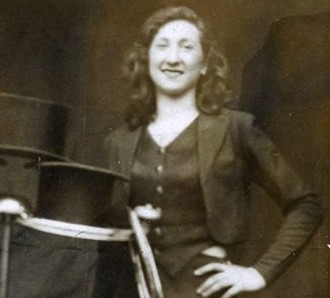“He had a spectacular scar that split his palm from index finger to his wrist,” recalls Bertrand Laurence of his strongman-acrobat grandfather, Houssein ben Ibrik. “It was from his early years in Morocco. To stop the attacking blade, he’d grabbed the sword of a pirate mounted on a camel. With his other hand, he swung Read More…
Author: admin
Rodion Nikitins (14.4.1915*) – A circus artist’s journey as an entertainer through Soviet and National Socialist occupation
The Latvian-born circus performer Rodion Nikitins lived through WWII performing in different circuses and theatres in Latvia, Germany and Nazi-occupied Prague. In his autobiography Of Flight and Freedom from 1987, Nikitins confesses that his work as an entertainer gave him more opportunities and options during WWII than those available to his family members or friends Read More…
Edit Sandor Kleinbarth (1931- ), a circus child during the war
Edit Sandor Kleinbarth was born in Budapest in 1931. Her parents were Sandor and Elise Kleinbarth. Her father came from a “private” Hungarian family. He had learned the art of school riding in the Czech Circus Henry. Also, he developed and presented animal revues with monkeys, ponies and donkeys. Her mother, however, came from the Read More…
The internement of the Sénécas in the wake of WWII: A family circus behind barbed wire
Originally from Belgium the Sénécas worked as a Circus family throughout France in the interwar period. As a travelling company and without a fixed residence, the nine children of Albert Sénéca (born 1907, Belgium) and Joséphine Sénéca, (born 1907, France), were born in different places in France. In the wake of WWII, the Sénéca family Read More…
The circus-menagerie Michelet and its bonds with the city of Gièvres
For decades, the Michelet family owned a menagerie-circus (first Ménagerie Lorraine Giacometti/ later Cirque-ménagerie Michelet). Many articles and advertisements published in newspapers state that this family activity goes back to the second half of the nineteenth century. On tour the family went into different partnerships with other well-known circus companies, like Albus and Grüss/Gruss. Henri Read More…
Links
http://www.circopedia.org/ http://www.circus-parade.com/ http://www.cirk75gmkg.com/ https://www.circusarchiv.de/
Literature
Adelsberger, Lucie: Auschwitz. Ein Tatsachenbericht. Berlin 1956. Adelsberger, Lucie: Auschwitz: A Doctor’s Story. Boston 1995. Adelson, Betty M.: The Lives of Dwarfs. Their Journey from Public Curiosity toward Social Liberation. New Brunswick u.a. 2015. Aiolfi, Marjorie; Bouglione, Louis Sampion: Le Cirque d’hiver. Paris 2002. Barré-Meinzer, Sylvestre: Le cirque classique, un spectacle actuel. Paris 2004. Bouglione, Read More…
Virtual Museum Exhibition
At a first preparatory meeting concerning the conceptualizing of the exhibition, the project members explored together with members of the circus community, including representatives of the German Society of Friends of the Circus and the European Circus Association, the limits and consequences of sharing in-group knowledge, information that may carry symbolic or social weight within Read More…
Historical Context
Even in times of crises and war, circuses have remained a popular form of amusement. Likewise, in the Nazi era circuses also attracted audiences hungry for entertainment. Moreover, within the Nazi sphere of control in Europe, circuses as cosmopolitan and mobile spheres could also offer refuge to those persecuted by the Nazi Regime and their Read More…
Projekt Diverging Fates
The project ‘Forgotten Cosmopolitans’ is based on a two-year pilot project (2017-2018) entitled ‘Diverging Fates: Travelling Circus People in Europe during National Socialism’. From this first scientific encounter the utilization of a biographical approach has resulted in a collection of short life stories, visible on the project’s website: www.divergingfates.eu. The follow-up project ‘Forgotten Cosmopolitans’ will Read More…










